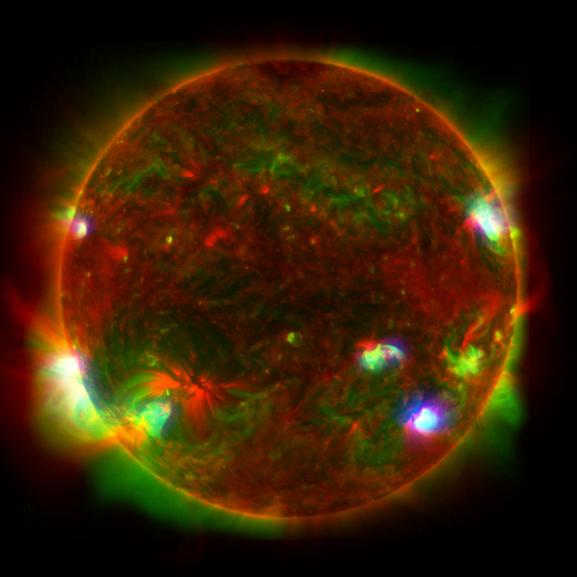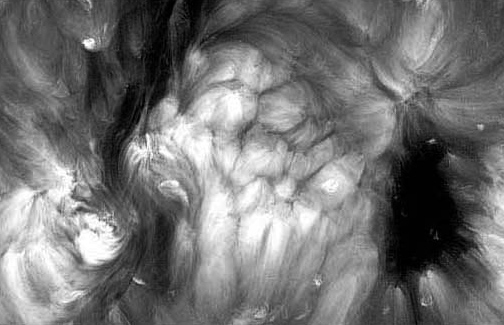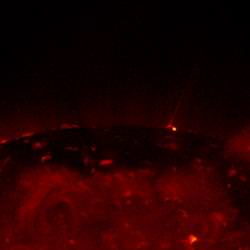You’ve probably never seen our Sun look like this before. This bizarre image of old Sol is made from data produced by three different space telescopes, each observing the Sun at a different wavelength.
Continue reading “Images From Three Telescopes Merged Into One Spectacular Picture of the Sun”Space Missions are Building Up a Detailed Map of the Sun’s Magnetic Field
Solar physicists have been having a field day of late. A variety of missions have been staring at the sun more intently ever before (please don’t try it at home). From the Parker Solar Probe to the Solar Orbiter, we are constantly collecting more and more data about our stellar neighbor. But it’s not just the big name missions that can collect useful data – sometimes information from missions as simple as a sounding rocket make all the difference.
That was the case for a group of scientists focused on the Sun’s chromosphere, the part of the suns’ atmosphere between the photosphere and the corona that is one of the least understood parts of the star. Now, with data collected from three different missions simultaneously, humanity has its first layered view of how the sun’s magnetic field works in this underexplored zone.
Continue reading “Space Missions are Building Up a Detailed Map of the Sun’s Magnetic Field”Orbiting Solar Observatory Sees It Burn, Burn, Burn: The Ring of Fire
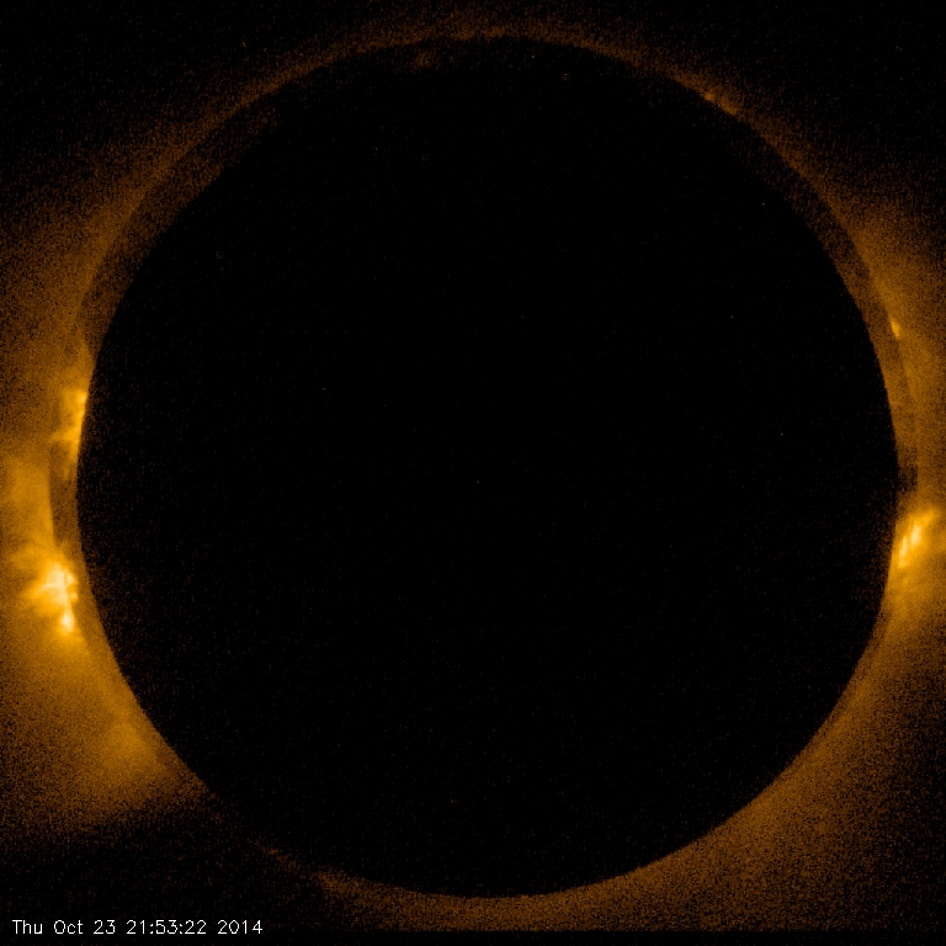
Did you catch the solar eclipse on October 23? If so, you saw the Moon “take a bite” out of the Sun (to various extents, depending on your location) during what was a partial eclipse for viewers on Earth. But for the Hinode (pronunciation alert: that’s “HEE-no-day”) solar observatory satellite, in its Sun-synchronous orbit around Earth at an altitude of 600 km (373 miles), the eclipse was annular – a “ring of fire.”
The image above was captured with Hinode’s X-ray Telescope at the moment of maximum annularity. Want to watch it burn, burn, burn like Hinode did? Check out a video below:
Not to be confused with “annual,” meaning yearly, an annular eclipse occurs when the Moon passes directly in front of the Sun but at such a distance from Earth to not quite manage to fully cover the Sun’s disk. The bright ring of visible Sun around the Moon’s silhouette gives the event its name: annular is from the Latin word anulus, meaning ring.
The next annular eclipse to be visible from Earth will occur on Sept. 1, 2016.
Led by the Japan Aerospace Exploration Agency (JAXA), the Hinode mission is a collaboration between the space agencies of Japan, the United States, the United Kingdom, and Europe, and is now in its eighth year. NASA helped in the development, funding, and assembly of the spacecraft’s three science instruments. Learn more about the mission here.
Image and video credits: NASA/JAXA/SAO
This Was the Best Watched Solar Flare Ever
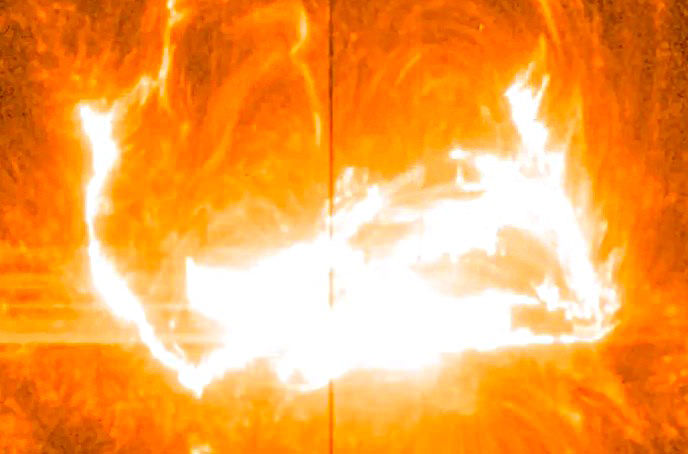
Are giant dragons flying out of the Sun? No, this is much more awesome than that: it’s an image of an X-class flare that erupted from active region 2017 on March 29, as seen by NASA’s Interface Region Imaging Spectrograph (IRIS) spacecraft. It was not only IRIS’s first view of such a powerful flare, but with four other solar observatories in space and on the ground watching at the same time it was the best-observed solar flare ever.
(But it does kind of look like a dragon. Or maybe a phoenix. Ah, pareidolia!)
Check out a video from NASA’s Goddard Space Flight Center below:
In addition to IRIS, the March 29 flare was observed by NASA’s Solar Dynamics Observatory (SDO), NASA’s Reuven Ramaty High Energy Solar Spectroscopic Imager (RHESSI), JAXA and NASA’s Hinode spacecraft, and the National Solar Observatory’s Dunn Solar Telescope in New Mexico.
With each telescope equipped with instruments specially designed to observe the Sun in specific wavelengths almost no detail of this particular flare went unnoticed, giving scientists comprehensive data on the complex behavior of a single solar eruption.
Also, for another look at this flare from SDO and a coronal dimming event apparently associated with it, check out Dean Pesnell’s entry on the SDO is GO! blog here.
Source: NASA/GSFC
This Energy-Boosting Region In The Sun Will Have A New NASA Satellite Watching It
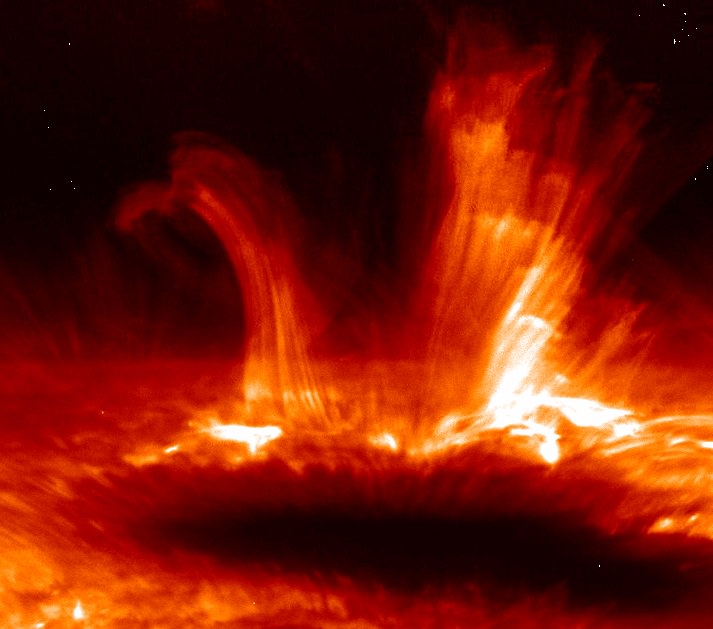
How does the sun’s energy flow? Despite the fact that we live relatively close (93 million miles, or eight light-minutes) to this star, and that we have several spacecraft peering at it, we still know little about how energy transfers through the solar atmosphere.
NASA’s next solar mission will launch Wednesday, June 26 (if all goes to plan) to try to learn a little bit more. It’s called the Interface Region Imaging Spectrograph (IRIS), and it will zero in on a spot in the sun’s lower atmosphere known as the “interface region.” The zone only has a thickness of 3,000 to 6,000 miles and is seen as a key transfer point to the sun’s incredibly hot corona (that you can see during total solar eclipses.)
“IRIS will extend our observations of the sun to a region that has historically been difficult to study,” stated Joe Davila, IRIS project scientist at NASA’s Goddard Space Flight Center. “Understanding the interface region better improves our understanding of the whole corona and, in turn, how it affects the solar system.”
Figuring out more about the interface region, NASA stated, will teach us a lot more about the “space weather” that affects Earth.
Some of the energy in the interface region leaks out and powers the solar wind, which is a sort of rain of particles that leave the star. Some of them hit the Earth’s magnetic field and can produce auroras. Most of the sun’s ultraviolet radiation also flows from the interface region.
IRIS’ images will be able to zero in on about 1 percent of the sun in a single go, with resolution of features of as small as 150 miles. The 400-pound satellite will orbit Earth in an orbit perpetually keeping it above the sunrise line, a spot that lets the satellite look at the sun continuously for eight months without the sun being obscured by Earth.
It’ll also form part of a larger network of sun-staring satellites.
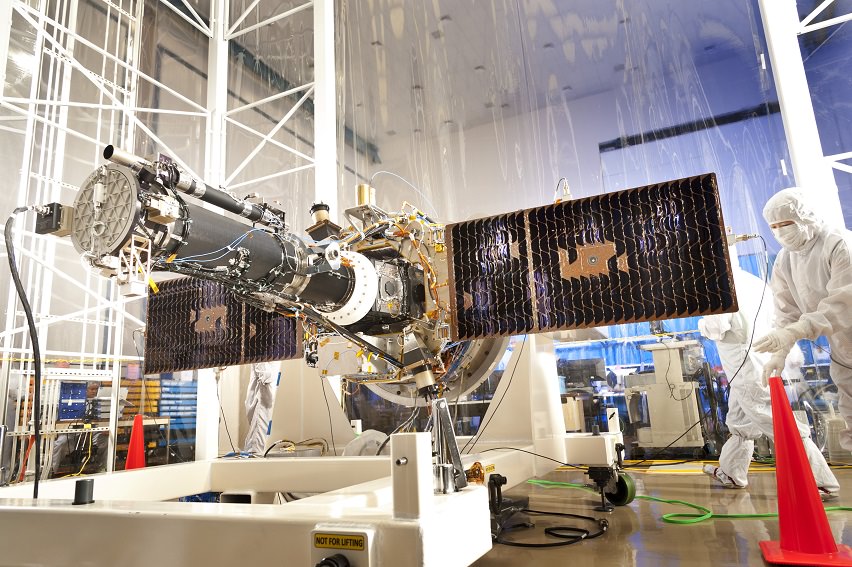
NASA highlighted its Solar Dynamics Observatory and a joint mission it has with Japan, called Hinode, which both take images of the sun in high-definition. These other two observatories, however, look at different solar layers (specifically, the surface and the outer atmosphere).
With IRIS joining the fleet and looking at the interface region, it will provide a more complete picture.
“Relating observations from IRIS to other solar observatories will open the door for crucial research into basic, unanswered questions about the corona,” stated Davila.
Source: NASA
Watch it Rain on the Sun
The big solar flare and coronal mass ejection earlier this week created an unusual event on the Sun: it rained. Not water drops of course, but coronal rain. After the eruption, blobs of plasma fell back to the surface of the Sun, sometimes making ‘splashes’ where they hit. Coronal rain is plasma gas that condenses in the corona and then descends back to the surface. It has long been a mystery and its motion has perplexed solar physicists. For some reason, coronal rain falls much slower than is expected for plasma falling due to the huge gravitational pull of the Sun. Many times, rather than falling straight down — as it would if gravity was the only force pulling on it — the plasma rain follows invisible magnetic field lines, which can be detected by instruments on board watchful spacecraft.
This video was produced from data from the Solar Optical Telescope on NASA/JAXA’s Hinode spacecraft of the big M1/7 class flare that erupted on April 16 from Active Region 1461. Scientists say thanks to spacecraft like Hinode and the Solar Dynamic Observatory, this phenomenon can be studied in much more detail so that they can better understand this unusual event.
Navy Scientists Spot New Solar Structures
[/caption]
There’s something new under the Sun… well, just above the Sun, actually. Scientists at the Naval Research Laboratory have spotted structures in the Sun’s super-hot corona that may shed some light on the way its magnetic fields evolve — especially near the edges of vast, wind-spewing coronal holes.
Coronal holes are regions where the Sun’s magnetic field doesn’t loop back down but rather streams outward into space. Appearing dark in images captured in ultraviolet wavelengths, these holes in the corona allow solar material to flow directly out into the solar system, in many cases doubling the normal rate of the solar wind.
Recently witnessed by NRL researchers using NASA’s SDO and STEREO solar-observing spacecraft, features called coronal cells exist at the boundaries of coronal holes and may be closely associated with their formation and behavior.
The coronal cells are plumes of magnetic activity that stream upward from the Sun, occurring in clusters. Likened to “candles on a birthday cake”, the incredibly hot (1 million K) plumes extend outwards, punching though the lower corona.
Seen near the center of the Sun’s disk, the cells appear structurally similar to granules — short-lived areas of rising and falling solar material on the Sun’s photosphere — but seen from an angle via STEREO, the cells were witnessed to be much larger, elongated and extending higher into the Sun’s atmosphere. For comparison, granules are typically about 1,000 km in diameter while the coronal cells have been measured at 30,000 km across.
“We think the coronal cells look like flames shooting up, like candles on a birthday cake,” said Neil Sheeley, a solar scientist at the Naval Research Laboratory in Washington, D.C. “When you see them from the side, they look like flames. When you look at them straight down they look like cells. And we had a great way of checking this out, because we could look at them from the top and from the side at the same time using observations from SDO, STEREO-A, and STEREO-B.”
Watch a video below of cells made from images acquired by STEREO-B… note how their elongated structure becomes evident as the cells rotate closer to the Sun’s limb.
NRL researchers also noted that the coronal cells appeared when adjacent coronal holes closed and disappeared when the holes opened, suggesting that the holes and cells share the same magnetic structure. In addition, the coronal cells were seen to disappear when a solar filament would erupt nearby, being “extinguished” as the cooler strand of solar material moved across them. Once the filament passed, the cells reformed — again, indicating a direct magnetic association.
The coronal cells were also identified in earlier images from ESA and NASA’s SOHO and Japan’s Hinode spacecraft.
It’s hoped that further study of these candle-like structures will lead to more knowledge of our star’s complex magnetic field and the effects it has on space weather and geomagnetic activity experienced here on Earth.
Read the press release from the Naval Research Laboratory here, and on NASA’s STEREO site here.
Previously Unseen Super-Hot Plasma Jets Heat the Sun’s Corona

[/caption]
The mystery of the Sun’s corona may finally be solved. For years researchers have known – and wondered why – the Sun’s outer atmosphere, or corona, is considerably hotter than its surface. But now, using the combined visual powers of NASA’s Solar Dynamics Observatory and Japan’s Hinode satellite, scientists have made direct observations of jets of plasma shooting off the Sun’s surface, heating the corona to millions of degrees. The existence of these small, narrow jets of plasma, called spicules has long been known, but they had never been directly studied before and were thought to be too cool to have any appreciable heating effect. But a good look with new “eyes” reveals a new kind of spicule that moves energy from the Sun’s interior to create its hot outer atmosphere.
“Heating of spicules to millions of degrees has never been directly observed, so their role in coronal heating had been dismissed as unlikely,” says Bart De Pontieu, the lead author and a solar physicist at LMSAL.
Solar physicst and former Universe Today writer Ian O’Neill (and current Discovery Space producer, and of Astroengine fame) compared the anomaly of the Sun’s atmosphere being hotter than the surface to if the air surrounding a light bulb was a couple of magnitudes hotter than the bulb’s surface. And, he said, you’d want to know why it appears the solar atmosphere is breaking all kinds of thermodynamic laws.
Over the years, experts have proposed a variety of theories, and as De Pontieu said, the spicule theory had been dismissed when it was found spicule plasma did not reach coronal temperatures.

But In 2007, De Pontieu and a group of researchers identified a new class of spicules that moved much faster and were shorter lived than the traditional spicules. These “Type II” spicules shoot upward at high speeds, often in excess of 60 miles per second (100 kilometers per second), before disappearing. The rapid disappearance of these jets suggested that the plasma they carried might get very hot, but direct observational evidence of this process was missing.
Enter SDO and its Atmospheric Imaging Assembly instrument which launched in February 2010, along with NASA’s Focal Plane Package for the Solar Optical Telescope (SOT) on the Japanese Hinode satellite.
“The high spatial and temporal resolution of the newer instruments was crucial in revealing this previously hidden coronal mass supply,” said Scott McIntosh, a solar physicist at NCAR’s High Altitude Observatory. “Our observations reveal, for the first time, the one-to-one connection between plasma that is heated to millions of degrees kelvin and the spicules that insert this plasma into the corona.”
The spicules are accelerated upward into the solar corona in fountain-like jets at speeds of approximately 31 to 62 miles per second (50 to 100 kilometers per second). The research team says that the majority of the plasma is heated to temperatures between 0.02 and 0.1 million Kelvin, while a small fraction is heated to temperatures above one million Kelvin.
A key step in learning more about the Sun, according to De Pontieu, will be to better understand the interface region between the Sun’s visible surface, or photosphere, and its corona. Another NASA mission, the Interface Region Imaging Spectrograph (IRIS), is scheduled for launch in 2012. IRIS will provide high-fidelity data on the complex processes and enormous contrasts of density, temperature, and magnetic field between the photosphere and corona. Researchers hope this will reveal more about the spicule heating and launch mechanisms.
This research appears in the 07 January issue of Science.
Sources: Science, Astroengine
Hinode Discovers the Sun’s Hidden Sparkle
Blinking spots of intense light are being observed all over the lower atmosphere of the Sun. Not just in the active regions, but in polar regions, quiet regions, sunspots, coronal holes and loops. These small explosions fire elegant jets of hot solar matter into space, generating X-rays as they go. Although X-ray jets are known to have existed for many years, the Japanese Hinode observatory is seeing these small flares with unprecedented clarity, showing us that X-ray jets may yet hold the answers to some of the most puzzling questions about the Sun and its hot corona.
Although a comparatively small mission (weighing 875 kg and operating just three instruments), Hinode is showing the world some stunning high resolution pictures of our nearest star. In Earth orbit and kitted out with an optical telescope (the Solar Optical Telescope, SOT), Extreme ultraviolet Imaging Spectrometer (EIS) and an X-Ray Telescope (XRT), the light emitted from the Sun can be split into its component optical, ultraviolet and X-ray wavelengths. This in itself is not new, but never before has mankind been able to view the Sun in such detail.
It is widely believed that the violent, churning solar surface may be the root cause of accelerating the solar wind (blasting hot solar particles into space at a mind-blowing 1.6 million kilometers per hour) and heating the million plus degree solar atmosphere. But the small-scale processes close to the Sun driving the whole system are only just beginning to come into focus.
Up until now, small-scale turbulent processes have been impossible to observe. Generally, any feature below 1000 km in size has remained undetected. Much like trying to follow a golf ball in flight from 200 meters away, it is very difficult (try it!). Compare this with Hinode, the same golf ball can be resolved by the SOT instrument from nearly 2000 km away. That’s one powerful telescope!
The limit of observable solar features has now been lifted. The SOT can resolve the fine structure of the solar surface to 180 km, this is an obvious improvement. Also, the EIS and XRT can capture images very quickly, one per second. The SOT can produce hi-res pictures every 5 minutes. Therefore, fast, explosive events such as flares can be tracked easier.
Putting this new technology to the test, a team led by Jonathan Cirtain, a solar physicist at NASA’s Marshall Space Flight Center, Huntsville, Alabama, has unveiled new results from research with the XRT instrument. X-ray jets in the highly dynamic chromosphere and lower corona appear to occur with greater regularity than previously thought.
X-ray jets are very important to solar physicists. As magnetic field lines are forced together, snap, and form new configurations, vast quantities of heat and light are generated in the form of a “microflare”. Although these are small events on a solar scale, they still generate huge amounts of energy, heating solar plasma to over 2 million Kelvin, create spurts of X-ray emitting plasma jets and generate waves. This is all very interesting, but why are jets so important?
The solar atmosphere (or corona) is hot. In fact, very hot. Actually, it is too hot. What I’m trying to say is that measurements of coronal particles tell us the atmosphere of the Sun is actually hotter than the Suns surface. Traditional thinking would suggest that this is wrong; all sorts of physical laws would be violated. The air around a light bulb isn’t hotter than the bulb itself, the heat from an object will decrease the further away you measure the temperature (obvious really). If you’re cold, you don’t move away from the fire, you get closer to it!
The Sun is different. Through interactions near the surface of the Sun between plasma and magnetic flux (a field known as “magnetohydrodynamics” – magneto = magnetic, hydro = fluid, dynamics = motion: “magnetic-fluid-motion” in plain English, or “MHD” for short), MHD waves are able to propagate and heat up the plasma. The MHD waves under scrutiny are known as “Alfvén wavesâ€? (named after Hannes Alfvén, 1908-1995, the plasma physics supremo) which, theoretically, carry enough energy from the Sun to heat the solar corona hotter than the solar surface. The one thing that has dogged the solar community for the last half a century is: how are Alfvén waves produced? Solar flares have always been a candidate as a source, but observation suggested that there wasn’t enough flares to generate enough waves. But now, with advanced optics used by Hinode, many small-scale events appear to be common… bringing us back to our X-ray jets…
Previously, only the largest X-ray jets have been observed, putting this phenomenon at the bottom of the priority list. NASA’s Marshall Space Flight Center group has now turned this idea on its head by observing hundreds of jet events each and every day:
“We now see that jets happen all the time, as often as 240 times a day. They appear at all latitudes, within coronal holes, inside sunspot groups, out in the middle of nowhere–in short, wherever we look on the sun we find these jets. They are a major form of solar activity” – Jonathan Cirtain, Marshall Space Flight Center.
So, this little solar probe has very quickly changed our views on solar physics. Launched on September 23, 2006, by a consortium of countries including Japan, USA and Europe, Hinode has already revolutionized our thinking about how the Sun works. Not only looking deep into the chaotic processes in the solar chromosphere, it is also finding new sources where Alfvén waves may be generated. Jets are now confirmed as common events that occur all over the Sun. Could they provide the corona with enough Alfvén waves to heat the Sun’s corona more than the Sun itself? I don’t know. But what I do know is, the sight of solar jets flashing to life in these movies is awesome, especially as you see the jet launch into space from the original flash. This is also a very good time to be seeing this amazing phenomenon, as Jonathan Cirtain points out the site of solar jets reminds him of “the twinkle of Christmas lights, randomly oriented. It’s very pretty”. Even the Sun is getting festive.

